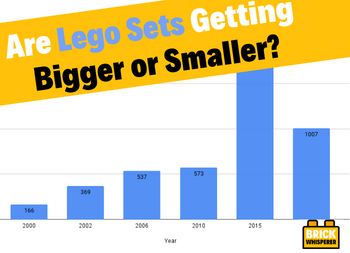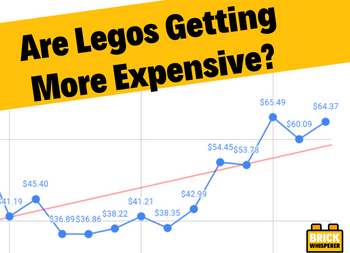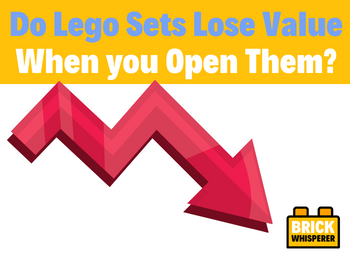Are Lego Sets Really Getting Smaller? (It’s a Myth!)
While browsing the Lego section at Walmart, I’ve noticed a few sets that were re-makes of sets I’ve bought in the past. For example, Boba Fett’s Ship (formerly known as Slave 1) has had a few recreations that look smaller than they used to be. So, I wanted to dive into this and see if it’s a real trend. So, I did a make-shift study and here’s what I found.
Legos Sets have not been getting smaller over the years, but actually larger. The number of pieces in a Lego Set has increased with remakes of old sets, as well an overall trend with new sets. Lego has also been proportionately raising its prices with the increase in number of pieces in their sets.
This claim may raise some eyebrows. I was fully expecting to see corporate greed and disproportionate raising of prices for smaller sets. No matter how I looked at the data, it’s clear that Lego Sets are getting larger and staying the same price. I am comparing sets from the Lego StarWars franchise, which people claim is the most unfairly priced of all Legos. I’ll prove this isn’t the case! Keep reading because I found this mini-study to be very interesting.
The Average Piece count of Lego Sets over the Years
I’ve put together a spreadsheet with every Lego Star Wars set from 1999 to 2022, including its retail price, piece count, and other specifics. I did some quick Excel math and found the average number of pieces for each year. I made sure to exclude Mini-figure, planet, and Micro-fighter sets that threw off the averages. I turned this information into a chart and we can see a clear trend in the number of pieces in a Lego Star Wars Sets over the years.
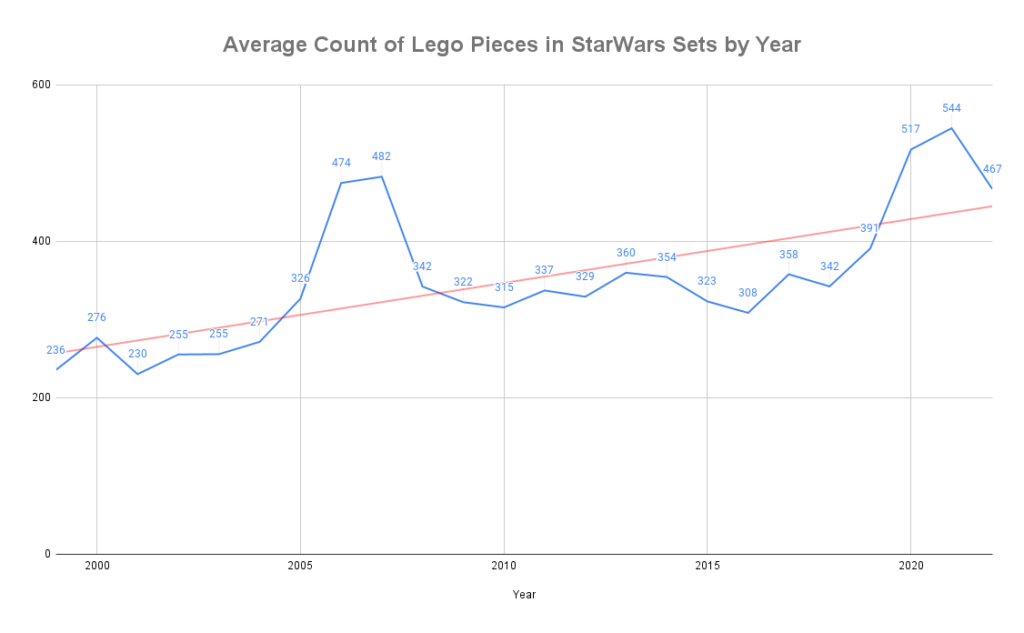
So, are Lego Sets getting smaller? With this chart, we determine:
The average number of pieces in a Lego StarWars Set has been increasing ever since its release. In 2021, there was an average of 544 bricks in a Lego set. This is over double the 236 average piece-count in 1999 when Lego StarWars first released.
However, this alone does not prove that Lego sets are getting larger. It may prove that there are more pieces in a set, but I didn’t take the time to compare the number of studs and smaller pieces in more recent sets to older sets. A higher amount of smaller bricks could drive up the average piece-count.
It could also mean that there was a higher number of sets released with more pieces in some years compared to others. That doesn’t necessarily mean that sets are getting bigger. What happened 2007 when the average number of pieces dropped from 482? There was a decrease in the average number of pieces between 2013 and 2016. With these events, I wouldn’t feel confident claiming that sets are getting smaller every year.
Comparing Lego sets Over the Years
I picked two Lego StarWars ships that have been re-created several times over. The “X-Wing” and “Slave 1” have had several renditions over the years, with some being bigger and better for sometimes an even better price. I want to compare each release to help answer the question: Are Legos getting smaller and more expensive?
I thought, what better way to answer that question than to compare the same set over a large period of time? It will reflect what The Lego Group is approving at that time, and could give us some insight on where Lego sets are headed.
For this mini-study, I found a list of every rendition of the Lego “Slave 1” and “X-Wing” on Brickipedia.fandom.com. I took data from my StarWars Lego Database and compiled them on my new Spreadsheet: Lego Set Variations Over the Years. If you want to fact check me, feel free to click the link and view it yourself.
Boba Fett’s Ship over the Years, Has is Gotten Smaller?
With every new edition of the Lego Slave 1, excluding the Ultimate Collector’s Series model, the model of the Slave 1 got bigger. On average, a Slave 1 Model Lego Set increases by 168 bricks with each new model, which hints that Lego Sets are getting larger over time.
There have been 6 renditions of the StarWars ship Slave 1, or 5 if you don’t count Jango Fett’s version. I made a list of each one then created a Bar Chart with the number of pieces per set, with a helpful image of each one with its retail price.
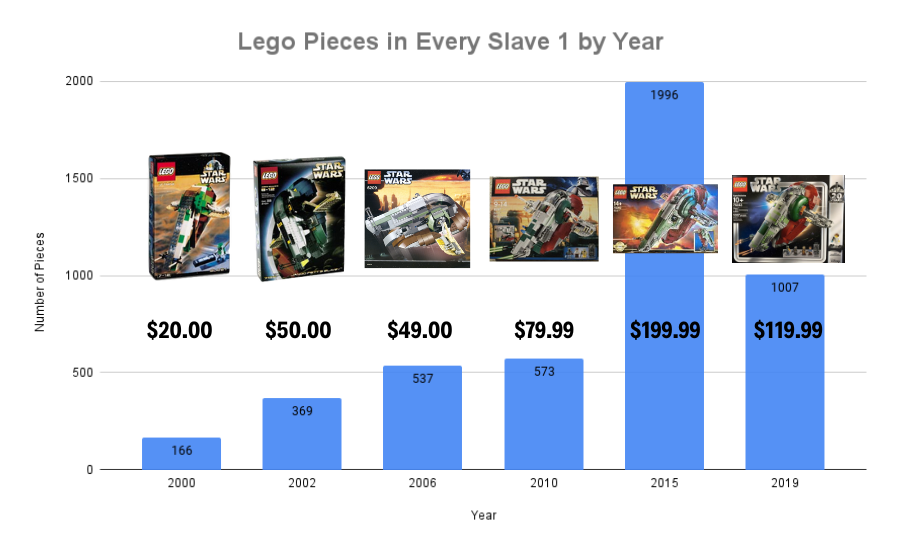
The number of pieces are graphed by the blue bars, the picture above each bar is that respective Lego set. The retail price of each Slave 1 is underneath their picture in bold. The retail price isn’t important when it comes to comparing the size of the set, but it is interesting to see.
We only have 6 models of one ship, so we can’t let this represent Lego sets as a whole. However, this is a clear example of Lego sets getting larger as time goes on. It’s a clear argument debunks the idea that Lego sets are getting smaller and more expensive.
I was curious at how the increase in size overtime affected its price. Is Lego fairly increasing the price of their sets as the size increases? A good way to check this is to calculate a Lego Set’s PPB (Price per brick). I do this by taking its retail price and dividing it by the number of pieces in the set. A good PPB for Lego StarWars is between $0.08 and $0.12. Let’s see the PPB of the Slave 1 over the years.
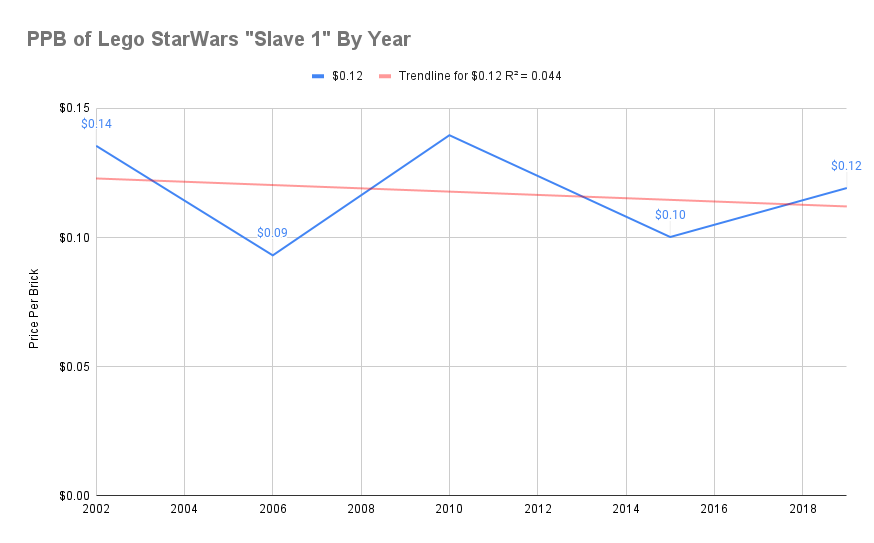
Looking at the trend of the PPB of a Lego StarWars Slave 1 model, we can see that there has been a slight decline over the years. This means that we are getting more Lego pieces for a lower cost, which is a good thing. However, there are only 6 Slave 1 ships, which means this isn’t a clear picture. If the next release of the ship is subpar, it would throw off all of this data.
What I’m saying is we can’t really tell if the Lego Slave 1 is becoming a better deal with every new release. While we can say that the ship is clearly getting bigger, we can’t confidently say it’s becoming a better deal.
X-Wings over the Years, Has it Gotten Smaller?
There have been 11 Lego X-Wing sets since 1999. With each new edition of the Lego X-Wing, its size has increased by 43 pieces. If we exclude the Ultimate Collector Series editions of the X-Wing, there was an average increase of 53 pieces. This is further proof that Lego Sets get larger over time.
Similar to the Slave 1, I made a list of each rendition of the Lego X-Wing and created a Bar Chart with the number of pieces per set, with a helpful image of each one with its retail price.

As you can see, there have been more remakes of the “X-Wing” than “Slave 1.” This helps in comparing the size over time to find out if Lego Sets are really getting bigger or smaller. I took an average of the difference in size between each set released, and found that each new set increased in size by 43 pieces. This jumped to 53 pieces when I took out the Ultimate Collector’s Series sets from 2000 and 2013. These abnormally large sets threw off the numbers a bit.
Removing the Ultimate Collector Series sets from the mix seemed interesting to me. I did just that with the following line chart, which shows a clear increase in the number of pieces in a set over the years.
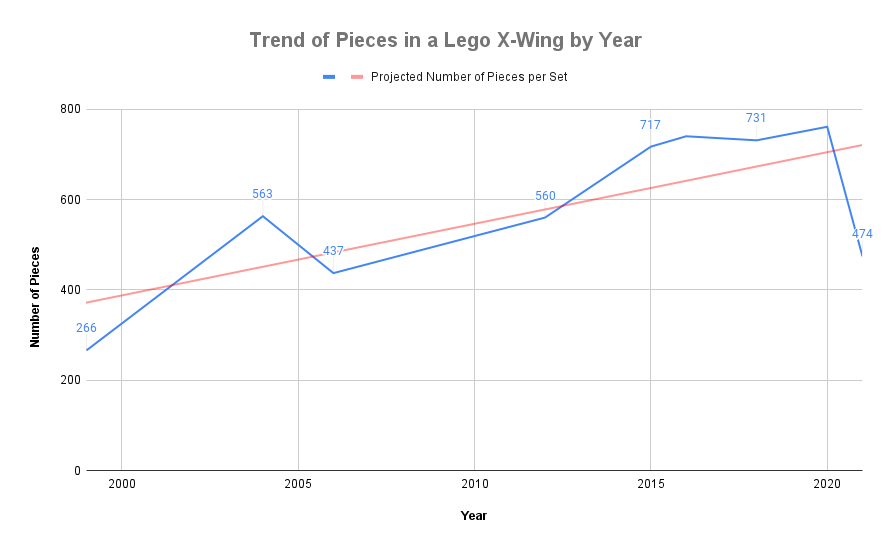
Each datapoint on the blue line the release of a Lego X-Wing. There are a few ups and downs with 2006 and 2021 having smaller sets than the year before, but the trend line in red shows a clear increase in the number of pieces in a set. With this data, we can expect future sets to have more pieces and become more detailed as Lego improves sets.
Like with the Slave 1, I wanted to see if Lego sets are becoming more expensive as they get larger. Remember, that we find this out by calculating the set’s PPB (Price per brick). If the PPB goes up over the years, that means the sets are increasing in price disproportionately to their size.

The PPB of an X-Wing has hovered between $0.13 and $0.09. This did exceed the $0.08 and $0.12 range, which I believe makes a Lego set a “fair price.” However, people have their own opinions and some think PPBs of as much as $0.16 to be fine.
What we’re really looking at here is the trend. With the small red line, we can see that the PPB of an X-Wing has stayed very constant over the 11 renditions of the set since 1999. This proves that as the number of pieces of this model have increased by 43 with every new set, the increase price has stayed constant with the increase in size. This means the Legos are getting more expensive, as they are getting larger in size, while fairly increasing in price.

